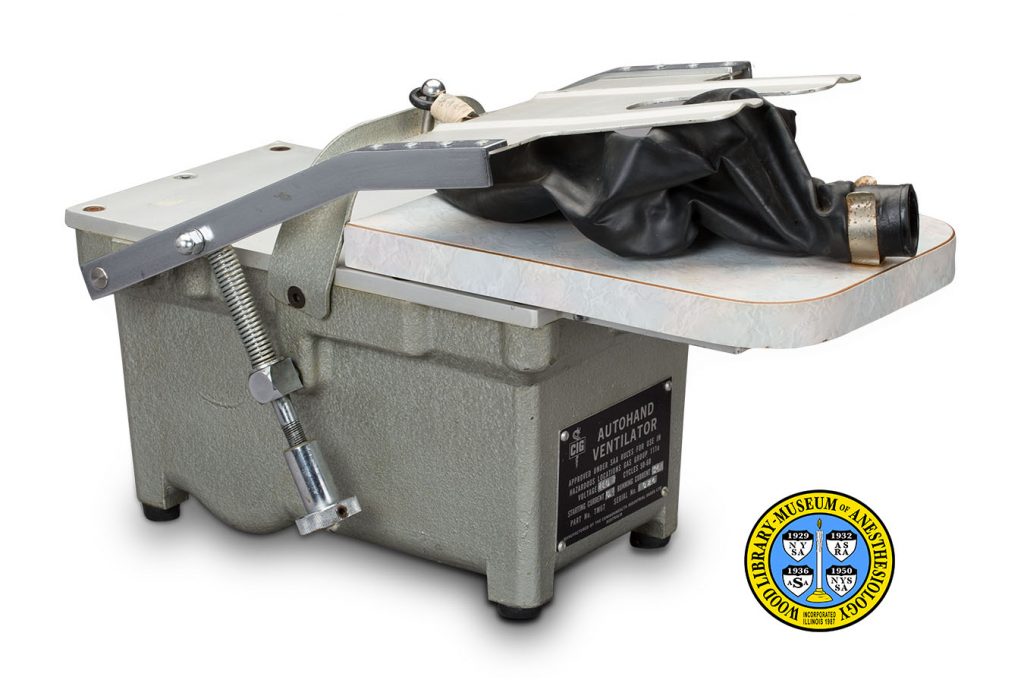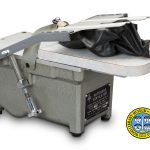CIG Autohand
Several Australian companies were combined in 1935 to form the largest supplier of medical and industrial gases in that country, Commonwealth Industrial Gases Ltd. (CIG). Among these were the two companies that had made the first anesthesia machines in Australia, both designed by leading anesthesiologist Geoffrey Kaye, M.D., F.F.A.R.C.S. (Hon.) (1903-1986).
Another Australian anesthesiologist and inventor, Norman R. James, F.F.A.R.A.C.S. (1908-1987) designed the first two ventilators made in Australia. In 1964, his career took him to Parkland Memorial Hospital, in Dallas, Texas, where he introduced his second ventilator, the James Autohand. In the 1970s, CIG manufactured a more compact version of the Autohand, shown here. The electrically-powered ventilator could be used with any anesthesia machine. It came equipped with both a rubber rebreathing bag for positive pressure ventilation, and corrugated rubber bellows for negative pressure. The bag and the bellows were interchangeable. The tidal volume delivered (the amount of air displaced between inhalation and exhalation) could be varied by adjusting a screw. The small size and flexibility of the Autohand suited it for use in developing countries and military medicine. It was used by the First Australian Field Hospital during the Vietnam War.
Catalog Record: CIG Autohand 34. CIG Auto Hand
Access Key: aqkm
Accession No.: 1977-06-15-1
Title: CIG autohand ventilator/ [designed by Norman James].
Author: James, Norman R. (1908-1987).
Corporate Author: Commonwealth Industrial Gases.
Title variation: Alt Title
Title: CIG Auto Hand
Title variation: Alt Title
Title: James Autohand
Publisher: Sydney, New South Wales, Australia : Commonwealth Industrial Gases, [between 1964 and 1977].
Physical Description: 1 automatic ventilator : metal, rubber ; 25 x 24 x 609 cm.
Subject: Ventilators, Mechanical.
Subject: Ventilators, Negative-Pressure.
Note Type: General
Notes: The first year in the range of the dates of possible manufacture is based on the information that an Autohand was used by Dr. James in 1964, but it appears more likely that the cataloged object was made in the 1970s. The second year in the date range is based on the date that the object was acquired.
The object is described with the label, and the open end of the rebreathing bag, facing forward.
Note Type: General
Notes: The Harry Daly Museum, in North Sydney, New South Wales, Australia, owns a somewhat different model of the CIG Autohand.
Note Type: Citation
Notes: Ball C, Westhorpe RN. The first anaesthetic ventilators. Anaesthesia and Critical Care. May, 2012;40(3):381.
Note Type: Citation
Notes: Commonwealth Industrial Gases Company File. Archives. Located at: Wood Library-Museum of Anesthesiology, Schaumburg, Illinois.
Note Type: Citation
Notes: Holland R. Decline and fall–a tragedy in three acts. Anaesth Intensive Care. June, 2007;35(Supplement 1): 11-16.
Note Type: Citation
Notes: Knight RJ. Resuscitation of battle casualties in South Vietnam: experiences at the First Australian Field Hospital. Resuscitation. April, 1973;2(1):17-31.
Note Type: Citation
Notes: Morley TR. Cardiac arrhythmias during laparoscopy. BMJ. April 29, 1972;2(5808):295-296.
Note Type: Citation
Notes: Westhorpe, Rod. Nitrous oxide in Australia and New Zealand. History of Anaesthesia Society Proceedings. December, 1994: 54-61.
Note Type: Citation
Notes: Westhorpe RN, Saidman LJ, Eger EI. Major anesthetic themes in the 1970s. In: Eger EI, Saidman LJ, Westhorpe RN, eds. The Wondrous Story of Anaesthesia. New York: Springer, 2014:105-118.
Note Type: Physical Description
Notes: One automatic ventilator; Consists of a metal base which houses a motor that drives the automatic ‘hand’ mechanism via a spring assembly on the left side of the apparatus; The ‘hand’ consists of a flat metal flange held by an armature attached to the base; A second armature holds a pin to which a rubber rebreathing bag is attached at the closed end; The open end of the bag is held in place by a metal clip near the front edge of the platform; A power cord emerges from the right side of the base;
The dimensions in the short description give the height when the ‘hand’ is at rest, that is, fully extended, and the depth with power cord at full extension; The power cord alone is approximately 564 cm in length; The cord is in poor condition, patched in several places and very stiff; When coiled, the cord adds approximately 20.5 centimeters to either the depth or the width, depending upon its position; The base casing and components of the ‘hand’ assembly are made of aluminum; the platform the bag rests on is laminate; The spring assembly is made of metal with and adjustable nut that limits how open the ‘hand’ can be;
A label plate on the front of the base reads: “[CIG logo] [new line] AUTOHAND [new line [VENTILATOR [new line] APPROVED UNDER SAA RULES FOR USE IN [new line] HAZARDOUD LOCATIONS GAS GROUP 111a [new line] Voltage 110 Cycles 50-60 [new line] Starting Current 6A Running Current 34A [new line] Part No. TM67 Serial No. 024 [new line] Manufactured by the Commonwealth Industrial Gases LTD [new line] Australia”.
Note Type: Reproduction
Notes: Photographed by Mr. Steve Donisch, June 19, 2017.
Note Type: Acquisition
Notes: Gift of Max Schnapp, M.D.
Note Type: Historical
Notes: Australian Oxygen Pty, Ltd. (Austox) was established in Melbourne, Victoria, Australia in 1909. Three years later, the British Oxygen Corporation set up Commonwealth Oxygen Co. (Comox) in Sydney, New South Wales, Australia. In 1923, Austox made the first anesthesia machine in that country, designed by leading anesthesiologist Geoffrey Kaye, M.D., F.F.A.R.C.S. (Hon.), F.F.A.R.C.S., D.A. (R.C.P.&S.) (1903-1986). Dr. Kaye’s second anesthesia machine was made in 1931 by John B. Arnold, Pty, Ltd. In 1935, Austox, Comox, Arnold and several other companies were combined to form the largest supplier of medical and industrial gases in Australia, Commonwealth Industrial Gases Ltd. (CIG.)
Another anesthesiologist and inventor, Norman R. James, F.F.A.R.C.S. (1908-1987) designed the first two ventilators made in Australia. The first of these was the Harrington-James Ventilator, introduced in 1950. Dr. James’ career later took him to Parkland Memorial Hospital in Dallas, Texas. There he introduced his second ventilator, the James Autohand. In the 1970s, CIG manufactured a more compact version of the Autohand. The electrically-powered ventilator could be used with any anesthesia machine. It came equipped with both a rubber rebreathing bag for positive pressure ventilation, and corrugated rubber bellows (concertina bag) for negative pressure; these were interchangeable. The cataloged example lacks the bellows. The tidal volume (the amount of air displaced between inhalation and exhalation) that the ventilator delivered could be varied by adjusting a screw. The small size and flexibility of the Autohand suited it for use in third world countries and military medicine. It was used by the First Australian Field Hospital during the Vietnam War.
Note Type: Exhibition
Notes: Selected for the WLM website.


